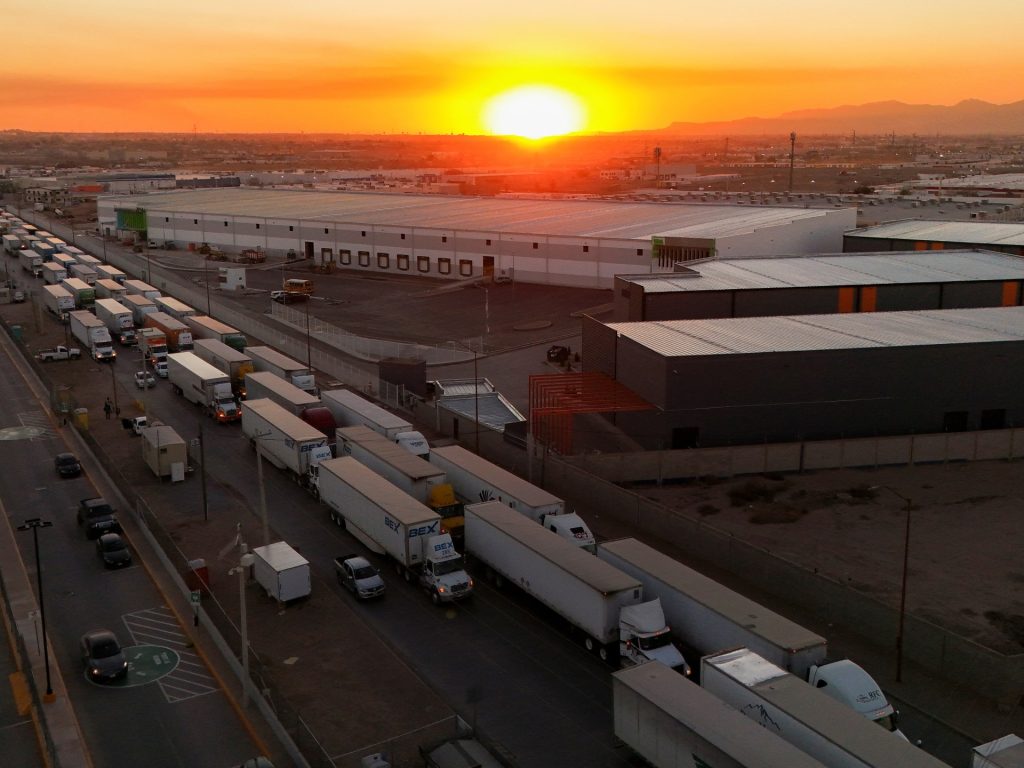US President Donald Trump has pushed into new trade law territory with an emergency sanctions law to justify punishing tariffs on Canadian and Mexican imports and an extra duty on Chinese goods.
Trump signed three separate executive orders on Saturday, imposing the tariffs, which have been globally criticised.
Here’s what you need to know about Trump’s tariffs and how the affected countries have retaliated.
What is Trump’s tariff plan?
It imposes a 10 percent bill on all imports from China and a 25 percent levy on goods from Mexico and Canada.
One exception to this is Canadian energy products, including oil, natural gas and electricity, which will be taxed at 10 percent.
The tariffs come with no exceptions, according to White House officials – and would even apply to Canadian imports values less than $800, which are currently duty-free.
Why is Trump imposing these tariffs?
Trump invoked the International Emergency Economic Powers Act (IEEPA) to impose the taxes, accusing the targeted countries of not doing enough to stop illegal immigration or drug trafficking into the United States.
The aim is to hold them “accountable to their promises of halting illegal immigration and stopping poisonous fentanyl and other drugs from flowing into our country”, the White House said in a statement.
The action makes good on Trump’s repeated campaign threat to impose widespread tariffs, a policy he defends and believes helps generate revenue, protect American jobs and create leverage.
The word “tariff”, Trump has often joked, “is the most beautiful word in the dictionary”.
Trump has repeatedly said he would like to see Canada become the “51st state”, and in January at the World Economic Forum in Davos, Switzerland, Trump called out his country’s northern neighbour.
“We have a tremendous deficit with Canada. We’re not going to have that any more. We can’t do it,” Trump said, teasing another way to avoid the tariffs.
“As you probably know, I say: ‘You can always become a state. And then, if you are a state, we won’t have a deficit. We won’t have to tariff you,’” Trump said.
When do the tariffs start to take effect?
Tariff collections are to begin at 12:01am EST (05:01 GMT) on Tuesday, according to Trump’s executive orders. But imports that were loaded onto a vessel or onto their final mode of transit before entering the US prior to 12:01am Saturday would be exempt from the duties.
The taxes will stay “until the crisis alleviated”, according to the White House, which provided no specific benchmarks needed for them to be lifted.
How has Canada reacted to Trump’s tariffs?
Canada’s Prime Minister Justin Trudeau begrudgingly announced Ottawa would respond in kind, putting 25 percent tariffs on up to $155bn in US imports.
Those tariffs would include American beer, wine and bourbon, as well as fruits and fruit juices, including orange juice from Trump’s home state of Florida, said Trudeau. Canada would also target goods including clothing, sports equipment and household appliances.
Trudeau questioned why Trump would threaten a historic US-Canada partnership that he said is the strongest “the world has ever seen”.
According to the US government, Canada was the largest buyer of the country’s goods in 2022, accounting for $356.5bn in purchases. An estimated $2.7bn worth of goods and services crossed the US-Canada border each day in 2023.
“The actions taken today by the White House split us apart instead of bringing us together,” said Trudeau. “We didn’t ask for this, but we will not back down.”
Mark Carney, a frontrunner to replace Trudeau as Canada’s next premier, also slammed the Trump tariffs and said Canada would be “united” and “stand up to a bully”.
President Trump thinks we’re pushovers. He doesn’t know Canadians.
We will stand up for our country. We will stand united. We will get stronger. Together. pic.twitter.com/XyPItjuWkP
— Mark Carney (@MarkJCarney) February 2, 2025
How has Mexico reacted to Trump’s tariffs?
Mexican President Claudia Sheinbaum on Saturday ordered retaliatory tariffs in response to the tariffs on all goods coming from Mexico.
In a lengthy post on X, Sheinbaum said her government sought dialogue rather than confrontation with its top trade partner to the north, but that Mexico had been forced to respond in kind.
“I’ve instructed my economy minister to implement the plan B we’ve been working on, which includes tariff and non-tariff measures in defence of Mexico’s interests,” Sheinbaum posted, without specifying what US goods her government will target.
The US is by far Mexico’s most important foreign market, and Mexico in 2023 overtook China as the top destination for US exports.
Mexico has been preparing possible retaliatory tariffs on imports from the US, ranging from five percent to 20 percent, on pork, cheese, fresh produce, manufactured steel and aluminium, according to sources familiar with the matter. The auto industry would initially be exempt, they said.
Economy Minister Marcelo Ebrard said on X that Trump’s tariffs were a “flagrant violation” of the US-Mexico-Canada Agreement.
“Plan B is under way,” Ebrard said. “We will win!”
US exports to Mexico accounted for more than $322bn in 2023, Census Bureau data showed, while the US imported more than $475bn worth of Mexican products.
In her post, Sheinbaum also rejected as “slander” the White House’s allegation that drug cartels have an alliance with the Mexican government, a point Trump’s administration used to justify the tariffs.
What was China’s response to the tariffs?
China’s government has denounced the tariffs and Trump’s demand that Beijing needed to staunch the flow of fentanyl, a deadly opioid, into the US, while leaving the door open for talks with the US that could avoid a deepening conflict.
Beijing will challenge Trump’s tariff at the World Trade Organization (WTO) – a symbolic gesture – and take unspecified “countermeasures” in response to the levy, which takes effect on Tuesday, China’s Finance and Commerce Ministries said.
That response stopped short of the immediate escalation that had marked China’s trade showdown with Trump in his first term as president and repeated the more measured language Beijing has used in recent weeks.
China’s toned-down response marked a contrast with the direct retaliation and heated language from Canada and Mexico.
China’s Commerce Ministry said in a statement that Trump’s move “seriously violates” international trade rules, urging the US to “engage in frank dialogue and strengthen cooperation”.
Filing a lawsuit with the WTO could give Beijing a win in messaging by standing up for the rules-based trading system long advocated by US administrations of both parties. Beijing has taken the same step in a challenge to tariffs of up to 45 percent on Chinese-made electric vehicles by the European Union.
At the same time, a WTO appeal poses no immediate cost or threat to Washington.
China’s sharpest pushback was over fentanyl, an area where the administration of former US President Joe Biden had also been urging Beijing to crack down on shipments of the China-made precursor chemicals needed to manufacture the drug.
“Fentanyl is America’s problem,” China’s Foreign Ministry said. “The Chinese side has carried out extensive anti-narcotics cooperation with the United States and achieved remarkable results.”
Have similar tariffs been used by the US in the past?
The closest parallel to Trump’s action was the late President Richard Nixon’s use of IEEPA’s predecessor law, the 1917 Trading With the Enemy Act, to impose a 10 percent across-the-board US tariff in 1971 to stem rising imports amid a balance-of-payments crisis after pulling the dollar off the gold standard.
Courts upheld Nixon’s action, but Jennifer Hillman, a trade law professor at Georgetown University and former World Trade Organization appellate judge, said Trump’s action may not fit the emergency.
The Nixon ruling and reporting requirement language in the IEEPA statute suggest that there needs to be a causal connection between the emergency – fentanyl and migrants – and the remedy: universal tariffs on Canada, Mexico and China.
“At least for me, I don’t think there is such a connection in this case,” Hillman said. “The tariffs would not be applied only to fentanyl, so there is not a clear reason why tariffs on all goods are ‘necessary’ to deal with a problem of fentanyl or migrants.”
Nixon’s use had a much clearer connection between the level of imports and the value of the dollar, she added.
What are experts saying?
Economic experts say the tariffs are likely to slow economic growth for all parties, while likely driving up inflation.
“Until now the market has really been on Trump’s side, but this is something where that could change and the market could challenge him for the first time,” said Mark Malek, chief investment officer of Siebert Financial in the US.
A new analysis by the Budget Lab at Yale laid out the possible damage to the US economy, saying the average household would lose the equivalent of $1,170 in income from the taxes.
Economist and former US Treasury Secretary Lawrence Summers said that jobs in the “industrial heartland will be lost as American producers can’t compete due to higher input costs”.
He said on X that Canada and Mexico will lose trust in the US and that the effect on the supply chain will be a “strategic gift” for China.
“Bullying doesn’t win over time on the playground or in the international arena,” Summers said.








